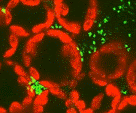Plant Pathology, Department of

Department of Plant Pathology: Faculty Publications
Document Type
Article
Date of this Version
11-13-2013
Citation
J. Virol. doi:10.1128/JVI.02737-13
Abstract
Viral coat proteins function in virion assembly and virus biology in a tightly coordinated manner with a role for virtually every amino acid. In this study, we demonstrated that the coat protein (CP) of Wheat streak mosaic virus (WSMV) (genus Tritimovirus; family Potyviridae) is unusually tolerant of extensive deletions with continued virion assembly and/or systemic infection. A series of deletion and point mutations were created in the CP cistron of wild-type and/or GFP-tagged WSMV and examined the effects of these mutations on cell-to-cell and systemic transport and virion assembly of WSMV. Mutants with overlapping deletions comprising N-terminal amino acids 6 to 27, 36 to 84, 85 to 100, 48 to 100, 36 to 100, or the C- terminal 14 or 17 amino acids systemically infected wheat with different efficiencies. However, mutation of conserved amino acids in the core domain, which may be involved in a salt bridge, abolished virion assembly and cell-to-cell movement. The N-terminal amino acids 6 to 27 and 85 to 100 are required for efficient virion assembly and cell-to-cell movement, while the C-terminal 65 amino acids are dispensable for virion assembly but required for cell-to-cell movement, suggesting that the C-terminus of CP functions as a dedicated cell-to-cell movement determinant. In contrast, amino acids 36 to 84 are expendable with no obvious effects on systemic infection and virion assembly. In total, 152 amino acids (6 to 27, 36 to 100 and 65 amino acids at the C- terminus end) of 349 amino acids of CP are dispensable for systemic infection and/or virion assembly, which is rare for multifunctional viral CPs.


Comments
Copyright 2013, American Society for Microbiology. All Rights Reserved.